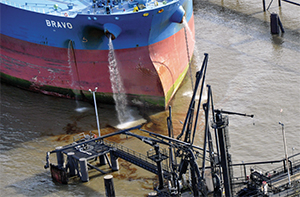An insufficient number of tugboats and an inadequate mooring arrangement were leading factors in the 2015 breakaway of a bulk carrier on the rain-swollen Lower Mississippi River, National Transportation Safety Board investigators determined.
The 751-foot bulker Privocean broke away from the Convent Marine Terminal in Convent, La., at 1553 on April 6, 2015, then floated across the river and struck the tanker Bravo at a terminal. Texas, one of two tugboats assigned to hold Privocean in place, became wedged between the two ships, injuring four of its crew. The incident caused $11 million in damage.
Privocean was secured to the Convent terminal with 14 mooring lines in addition to the hold-in tugs. The NTSB said those measures weren’t enough with the river at 14 feet.
“The probable cause of the collision … was the inadequate mooring arrangement for the Privocean and the insufficient number of hold-in tugs provided by the vessel operator given the prevailing conditions,” the NTSB report said.
Bariba Group of Athens, Greece, is Privocean’s parent company, while Bravo Shipping Ltd. of St. Vincent and the Grenadines operates Bravo. Malta is the flag state for both ships. Crescent Towing of New Orleans operates Texas.
Crescent declined to comment and attempts to reach the shipping companies to discuss the report were not successful. The incident spurred several lawsuits, and a judge later ordered Privocean arrested to prevent it from leaving the country. The ship has since left U.S. waters.
Privocean arrived at the Convent terminal two days before the accident and moored with its bow facing upriver. The master secured it to the pier using 14 polypropylene mooring lines instead of the traditional 10, the report said. The lines were eight-strand, 64-millimeter-diameter hawsers rated for 69.3 tons made by Shenli Rope-Making Co.
The vessel tied off with four bowlines, two forward spring lines, two aft spring lines, two aft breast lines and four stern lines, the report said. The master agreed to the line placement but later told investigators he remained leery of the setup, particularly the lack of “good mooring points” on the terminal dock for the breast lines. He also expressed these concerns to the ship agent.
The ship took on a load of coal at the Convent terminal, increasing its draft to about 45 feet, subjecting more of the ship’s hull to the strong currents and placing additional strain on the lines. During loading, the ship was seen moving about seven to 10 feet from the pier.
The 4,200-hp Texas was stationed at Privocean’s port bow during loading, pushing against its hull at three-quarters power. About an hour before the allision, the cargo agent on the ship requested even more power to stem the vessel’s motion at the pier, the report said. The second tug, Ned Ferry, was at the port stern. Three minutes before the breakaway, the ship’s master requested a third hold-in tug from the chartering agent.
“The first forward mooring hawser parted at about 1551,” the report said. “The master said that the remaining lines parted or paid out under ‘tremendous strain’ during the next three minutes, and the Privocean began to drift in the current and started crossing the river.”
The master dropped the starboard anchor but it dragged. Privocean drifted across the river and hit Bravo, an 816-foot oil tanker offloading product at the Ergon-St. James Terminal about a half-mile downriver. Bravo’s master initiated emergency procedures just before the accident, likely preventing a serious spill. Roughly 10 barrels of oil reached the river.
Ned Ferry’s crew got one line free from Privocean, but the current pushed the line into the tug’s starboard propeller. The bulker’s crew released the tug’s second line. Texas could not release its lines and became pinned between Privocean and Bravo. The tug’s captain, wheelman, deck hand and engineer reported arm, leg and ligament injuries, the report said.
Investigators noted Bravo was secured to the pier with 17 mooring lines and two hold-in tugs, Admiral Jackson and G. Shelby Friedrichs. All 17 lines parted upon impact with Privocean, although Bravo dropped its anchors and stopped after about 500 feet.
The accident caused about $250,000 in damage to Privocean and about $1.5 million in damage to both Bravo and Texas. The bulk of the damage occurred to the Ergon-St. James Terminal, where repairs cost about $9 million.
About three weeks after the incident, Convent Marine Terminal released mooring guidance for vessels to consider during high water. The plan recommends, at a minimum, two anchors out of pocket ready for deployment, bowlines connected to upriver mooring dolphins, breast lines on the bow and stern, and doubling of breast lines at the bow.

